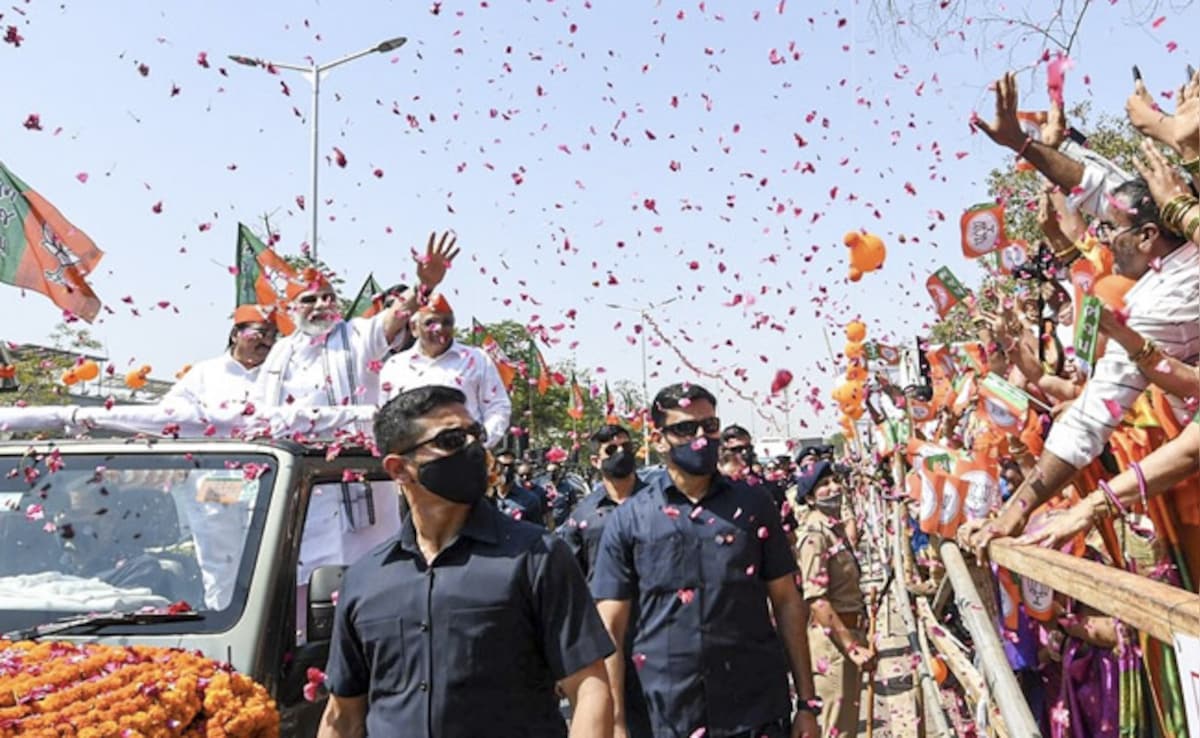
Gujarat has been a Bharatiya Janata Party (BJP) bastion ever since the party's historic win in the state in 1995. For the upcoming general elections, the party is confident that it will retain all 26 Lok Sabha seats in the state. The Congress is set to contest 24 seats, while the Aam Aadmi Party (AAP) has fielded candidates in Bharuch and Bhavnagar.
In the 2022 state assembly polls, the BJP had secured a record 156 out of 182 seats. This was when the Congress and the AAP were contesting separately. The results and the campaign underlined the fact that ‘Brand Modi' was unshaken and that Prime Minister Narendra Modi continued to be the BJP's biggest trump card for voters.
Impressive Track Record
The BJP has won seven consecutive assembly elections since 1995, an incredible feat in itself. By the time the current assembly completes its term in 2027, the BJP government will have been in the state for 32 years – just one year and 11 months less than the Communist Party of India-Marxist's (CPI-M) nearly 34-year reign in West Bengal from 1977 to 2011.
In the 2022 assembly elections, the BJP won a record 156 seats in Gujarat with a 52.5% vote share, while the opposition Congress and AAP, got around 27% and 13% votes, respectively. The Congress could win just 17 seats, while the AAP managed to secure five. Independents won three seats and the Samajwadi Party picked up one.
The BJP has managed to maintain its supremacy in Lok Sabha elections as well. In 1998, the party won 19 of the 26 seats, while in 1999, it won 20. The BJP's tally dropped to 14 seats in the 2004 Lok Sabha polls, just two more than the Congress's 12 seats. In 2009, the BJP managed to improve its tally by one, securing 15 seats. It has been a clean sweep in the last two Lok Sabha elections.
Region-Wise Battle
Gujarat can be divided into four regions, namely, Saurashtra and Kutch, and the northern, southern and central parts of the state. The eight Lok Sabha seats in the Saurashtra and Kutch region have been with the BJP for a long time.
North Gujarat has seven seats, including the high-profile Gandhinagar, which is represented by Union Home Minister Amit Shah. The two seats of Ahmedabad are also part of this region.
Central Gujarat has six seats, including Vadodara and the tribal-dominated Dahod, Panchmahal and Chhota Udaipur seats. Tribal votes in this area are crucial for the BJP if it wants to repeat its clean sweep of 2014 and 2019.
South Gujarat has five seats. It includes the diamond hub Surat, and Bharuch and Navsari. Gujarat BJP chief C.R. Paatil is contesting from Navsari, a seat he has won previously with record margins. In Bharuch, the contest may turn interesting given that the AAP is contesting in an alliance with the Congress. The candidate it has chosen for the Bharuch battle is MLA and an emerging tribal leader Chaitar Vasava. He will face BJP MP Mansukh Vasava, who has been elected from the seat several times.
Historically, Patidars, or Patels, have always been loyal to the BJP. Political watchers opine that the community turned against the Congress in the 1980s, when its chief minister Madhavsinh Solanki started nurturing the “KHAM” vote bank (Kshyatriyas, Harijans, Adivasis and Muslims). The combination proved successful for the party — it bagged 142 seats in 1980 and 149 seats in 1985.
The patidars in turn, miffed with the Congress, started bonding with the BJP under the leadership of former chief minister Keshubhai Patel, who went on to form the first BJP-led government in the state in 1995. Though his tenure was cut short due to rebellion in the party ranks, Patel returned as chief minister in 1998-2001. Since then, Patidars have been loyal supporters of the party, barring the brief disenchantment with it in 2017, when Hardik Patel organised a statewide campaign demanding reservations for Patidars in higher education and jobs. In the assembly elections that year, the BJP could win merely 99 seats. Hardik Patel is now part of the BJP.
What has also helped the BJP in Gujarat is capturing Hindu votes through the Ayodhya movement, which gained momentum from Somnath on Gujarat's coast.
Speaking about the rise of the BJP in Gujarat, sociologist Gaurang Jani says, “After Gujarat was carved out of Bombay State (May 1960), communal riots took place regularly. There were two anti-reservation stirs before the BJP formed the government in 1995. Ram Janmabhoomi movement was started. The Gandhian movement had faded here by then and there were no Left parties in Gujarat. So, there was a vacuum.”
“The BJP initially supported upper caste Hindus in the anti-reservation movement. Brahmins, Patels, Banias and Kshatriyas are the four components of the upper castes in Gujarat. The Solanki government lacked representation of these communities and was formed of SC, ST, OBC and minorities. The BJP capitalised on this plank by offering a Hindutva umbrella,” Jani adds.
The BJP's formidable social engineering and its Hindutva credentials are expected to pay off in the upcoming elections too. However, there have been reports of some dissent over the selection of candidates in constituencies like Amreli, Rajkot, Sabarkantha, Surendranagar and Vadodara.
However, such incidents are unlikely to dent the party's prospects. In terms of governance and ideology, the people in the state continue to trust Modi and the BJP far more than any other party. That is the sense one get after talking multiple stakeholders.
New initiatives like setting up MSMEs and projects in Rann of Kutch have helped in creating direct and indirect employment.
(Bharti Mishra Nath is a senior journalist)
Disclaimer: These are the personal opinions of the author


